
Amsterdam Zuid is a railway station situated in the borough of Amsterdam-Zuid in Amsterdam, Netherlands. For a number of years, it was named Amsterdam Zuid WTC, in reference to the neighbouring World Trade Center Amsterdam. During 2006, in conjunction with the rapid development of the area surrounding the station, the station was enlarged and the reference to the WTC was formally dropped from the name.

The Dutch Waterline was a series of water-based defences conceived by Maurice of Nassau in the early 17th century, and realised by his half brother Frederick Henry. Combined with natural bodies of water, the Waterline could be used to transform Holland, the westernmost region of the Netherlands and adjacent to the North Sea, almost into an island. In the 19th century, the Line was extended to include Utrecht.

Weespstation is a railway station in Weesp, Netherlands. The station has two island platforms and a total of six tracks, two of which are used for passing trains. The Schiphollijn, Flevolijn and Gooilijn meet at Weesp making it an important transfer station for passengers going between Amsterdam, Hilversum and Almere. The first station in Weesp opened on June 10, 1874, when the Gooilijn from Amsterdam to Hilversum and Amersfoort was completed. The original station was demolished in 1967 and replaced by a new building. The new building partially went out of service in 1985 because of the new railway line from Weesp to Almere and beyond, called the Flevolijn. The out-of-service part was later converted to a bicycle parking and repair shop. The remaining station is little more than a tunnel passing under the tracks, and a small coffee counter. Train services are operated by Nederlandse Spoorwegen.

Hoofddorp is a railway station in Hoofddorp, Netherlands located on the Weesp–Leiden railway.

Duivendrecht station (DVD) is a combined rail and metro station in Duivendrecht, Netherlands. The station opened on 23 May 1993 as part of the extension of the Zuidtak of the Amsterdam Ringspoorbaan, between Amsterdam RAI and Weesp. This station allows for the interchange between two grade-separated railways:
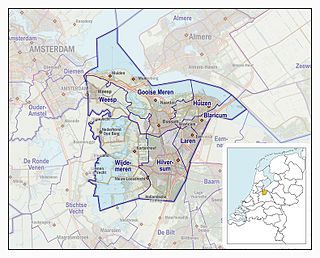
The Gooi is an area around Hilversum, in the centre of the Netherlands. It is a slightly hilly area characterised by its green landscape, its historical charm, the wealth of its inhabitants and its villas. The Gooi is known in the country as the home of the rich and famous.

Amsterdam Muiderpoort is a railway station in the east of Amsterdam. It was reopened on 15 October 1939 after being first opened in 1896. It is located 4 km southeast of Amsterdam Centraal. At this station the Amsterdam–Arnhem railway and the Amsterdam–Zutphen railway split, with the two parts of the station separated (keilbahnhof). The western part is the Amsterdam Centraal to Utrecht Centraal line. The eastern part is the Amsterdam Centraal to Amersfoort Centraal line. The station is operated by the Nederlandse Spoorwegen.
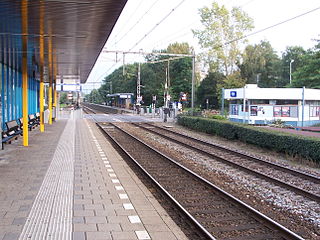
Diemen is the main railway station of the municipality of Diemen, Netherlands. It is located on the Amsterdam–Zutphen railway between Amsterdam Science Park and Weesp. The station was first opened in 1882 and then closed in 1929. It was reopened at the same location in 1974. The station building was completed in 1978. The train services are operated by Nederlandse Spoorwegen. Among the direct destinations are Almere, Amersfoort, Amsterdam Centraal, Hilversum, Lelystad, and Zwolle. There are connections to two bus services operated by GVB.

Naarden-Bussum is a railway station in the north of Bussum, Netherlands that also serves the neighboring community of Naarden. The station has two standard platforms. It has a total of two tracks. The station was opened on 10 June 1874. The station is on the Amsterdam - Hilversum - Amersfoort line, known as the Gooilijn. The station was also used as a tram station for the Bussum - Huizen tram service from 1883 to 1958.

Almere Oostvaarders is a railway station in Almere, Netherlands. It is located 29 km (18.0 mi) east of Amsterdam, on the Amsterdam - Almere - Lelystad main line. It is approximately 3 km (1.9 mi) northeast of the Almere city centre. Almere Oostvaarders railway station opened on 12 December 2004.

Amersfoort Centraal is the main railway station in Amersfoort in the province of Utrecht, Netherlands. The station was an important link between the western part of the Netherlands and the north and east of the country until December 2012 when the Hanzelijn opened.

The Amsterdam–Zutphen railway is a railway line in the Netherlands running from Amsterdam, North Holland to Zutphen, Gelderland via the province of Utrecht. It passes through the cities of Hilversum, Amersfoort and Apeldoorn. It is also informally called the Oosterspoorweg, with the part between Amsterdam and Amersfoort sometimes being called the Gooilijn because of the region it runs through.

Amsterdam Science Park is a railway station in the borough Amsterdam-Oost in Amsterdam, Netherlands. The station lies on the Amsterdam–Zutphen railway between the railway stations Amsterdam Muiderpoort and Diemen. The station serves the Science Park Amsterdam and the Watergraafsmeer, as well as Amsterdam University College and the Science Park campus of the University of Amsterdam. The construction of the station started in June 2009 and it was opened on 13 December 2009 by Amsterdam Mayor Job Cohen.

The Schiedam train disaster took place in the Netherlands on 4 May 1976 near the station Schiedam Rotterdam-West. The international Rhine Express boat train from Hook of Holland, which left for Munich and was hauled by NS Class 1300 electric locomotive no. 1311 Best collided with a train of the then new sprinter type, coming from Rotterdam. The collision caused the deaths of 24 people, five people were severely injured and dozens more had minor injuries.
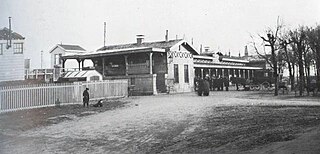
On 10 August, 1856 two passenger trains collided at the Amsterdam–Haarlem–Rotterdam railway near Delfshaven between Schiedam Centrum station and Rotterdam Centraal station, the Netherlands. Two carriages where destroyed with a third being severely damaged. Three passengers lost their lives and at least nine were injured.
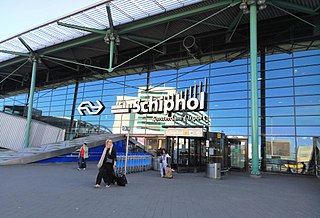
Schiphol Airport railway station is a major passenger railway station in Haarlemmermeer, Netherlands, beneath the terminal complex of Amsterdam Airport Schiphol, operated by the Nederlandse Spoorwegen. The station's six platforms are accessible via twelve escalators and three elevators located in the main concourse of the airport. The original station was opened in 1978, and the current station in 1995. It connects the airport to Amsterdam and other cities in the Netherlands, as well as to Belgium and France.
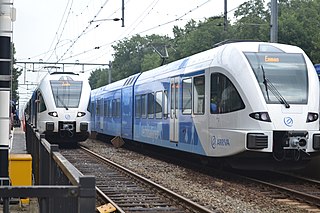
The Dalfsen train crash occurred on 23 February 2016 when a passenger train collided with a tracked elevated work platform on a level crossing at Dalfsen, Overijssel, Netherlands. One person was killed and six were injured, one seriously.

The NS 6100 was a series of tank engines with the 2'C2' (4-6-4) wheel arrangement of the Dutch Railways (NS). They were manufactured by Hohenzollern and Werkspoor.
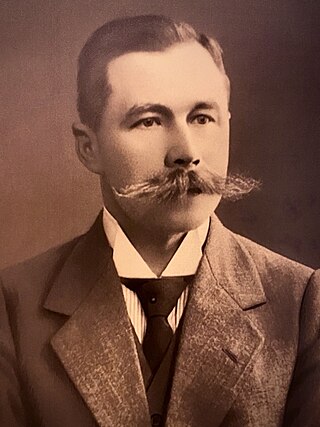
Hendrikus Jacobus Gorter (1874-1918) was a Dutch cyclist, speed skater and ice skates manufacturer from Zwolle. He passed away prematurely during the 1918 Weesp train disaster.




















